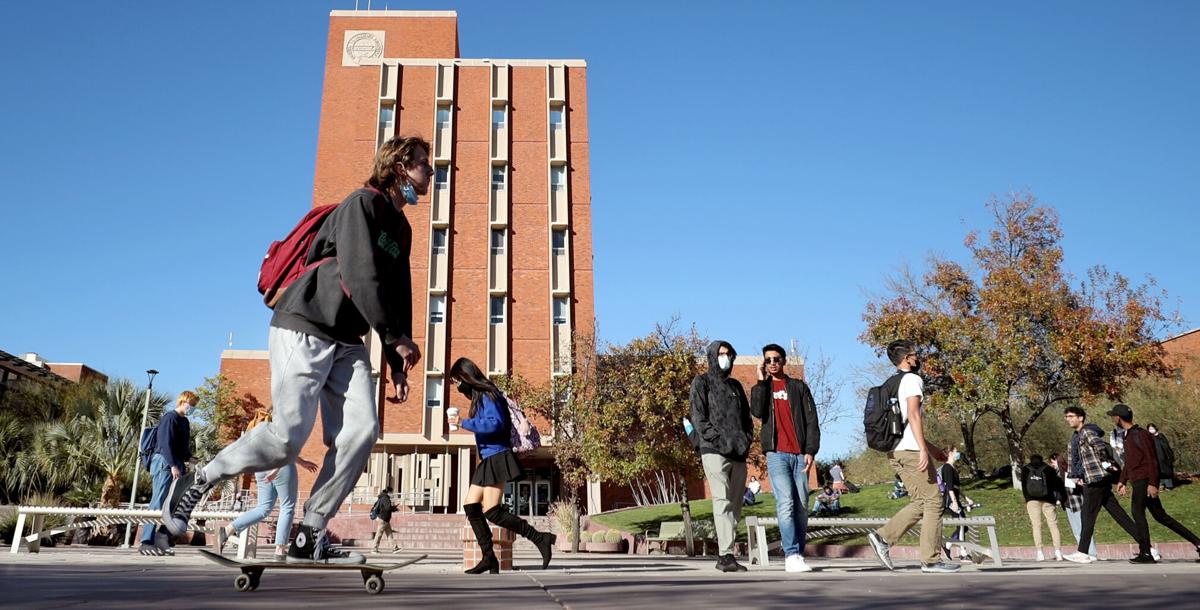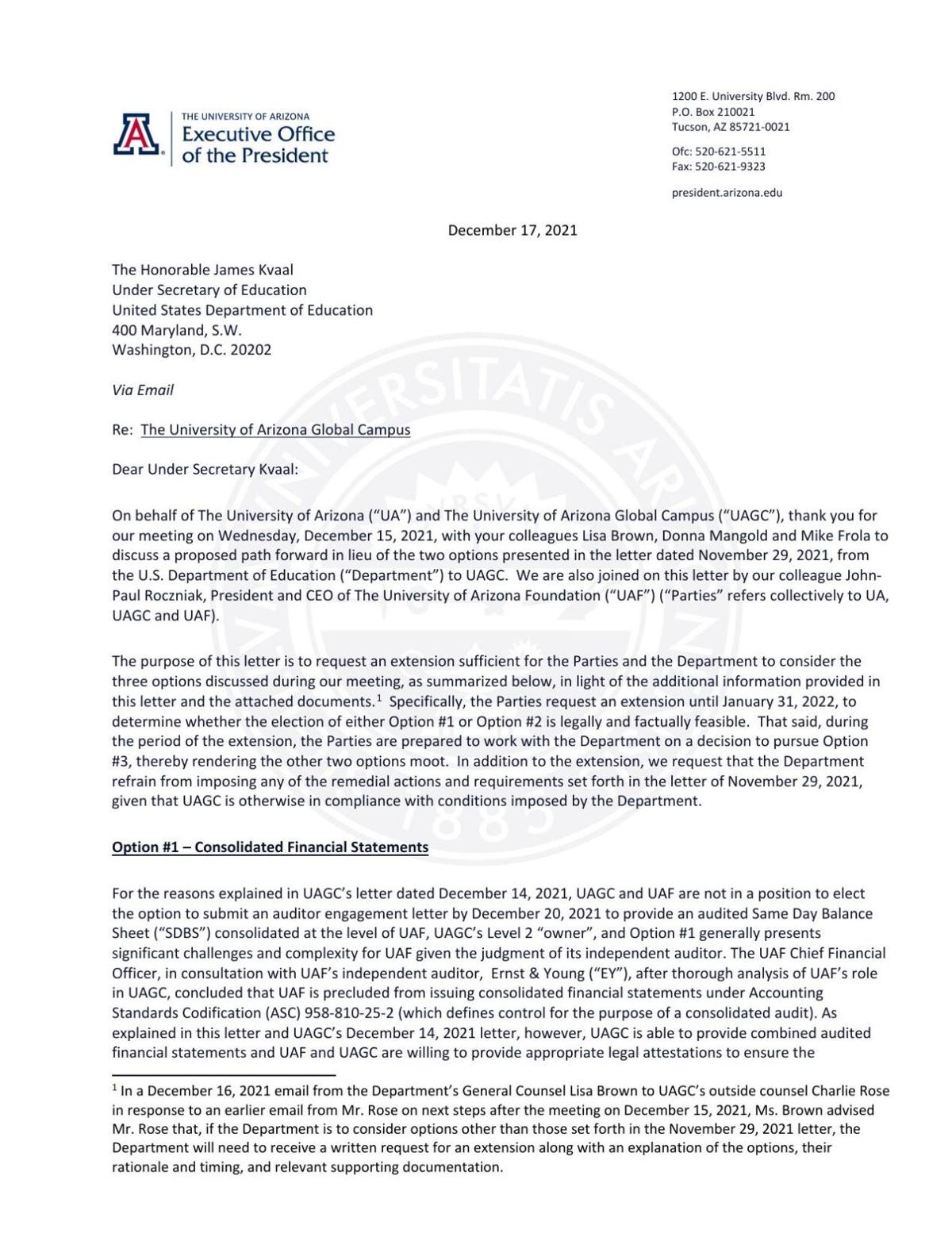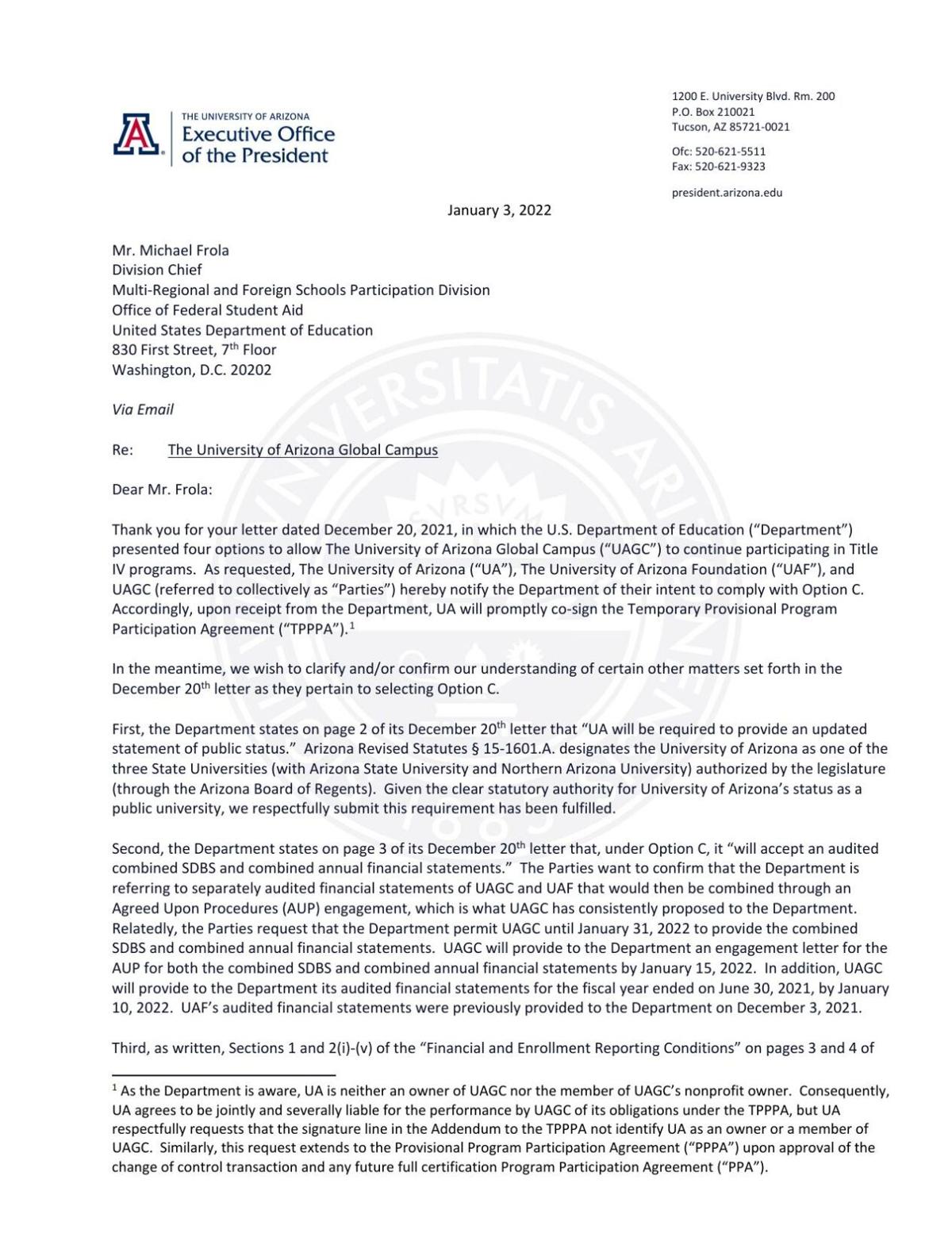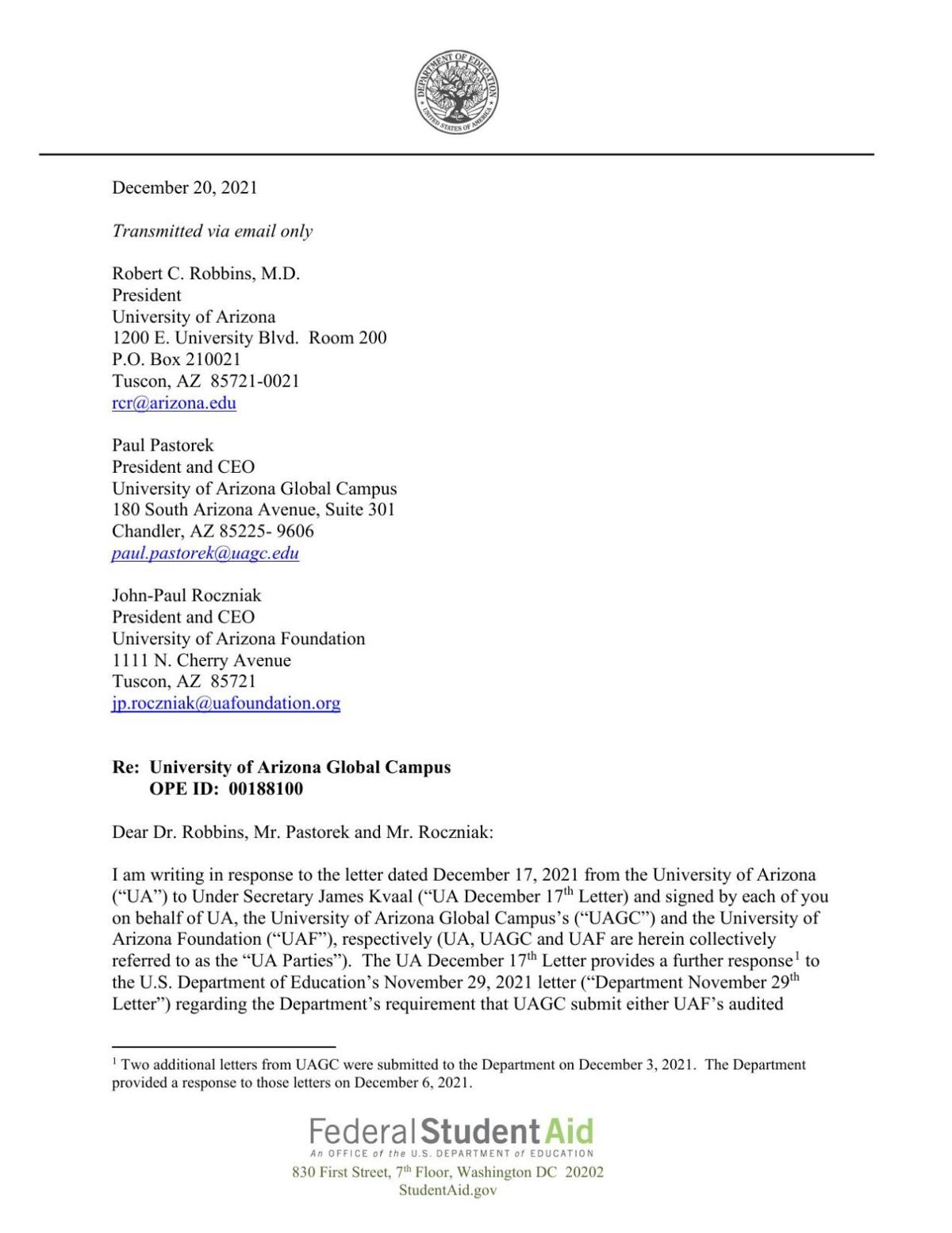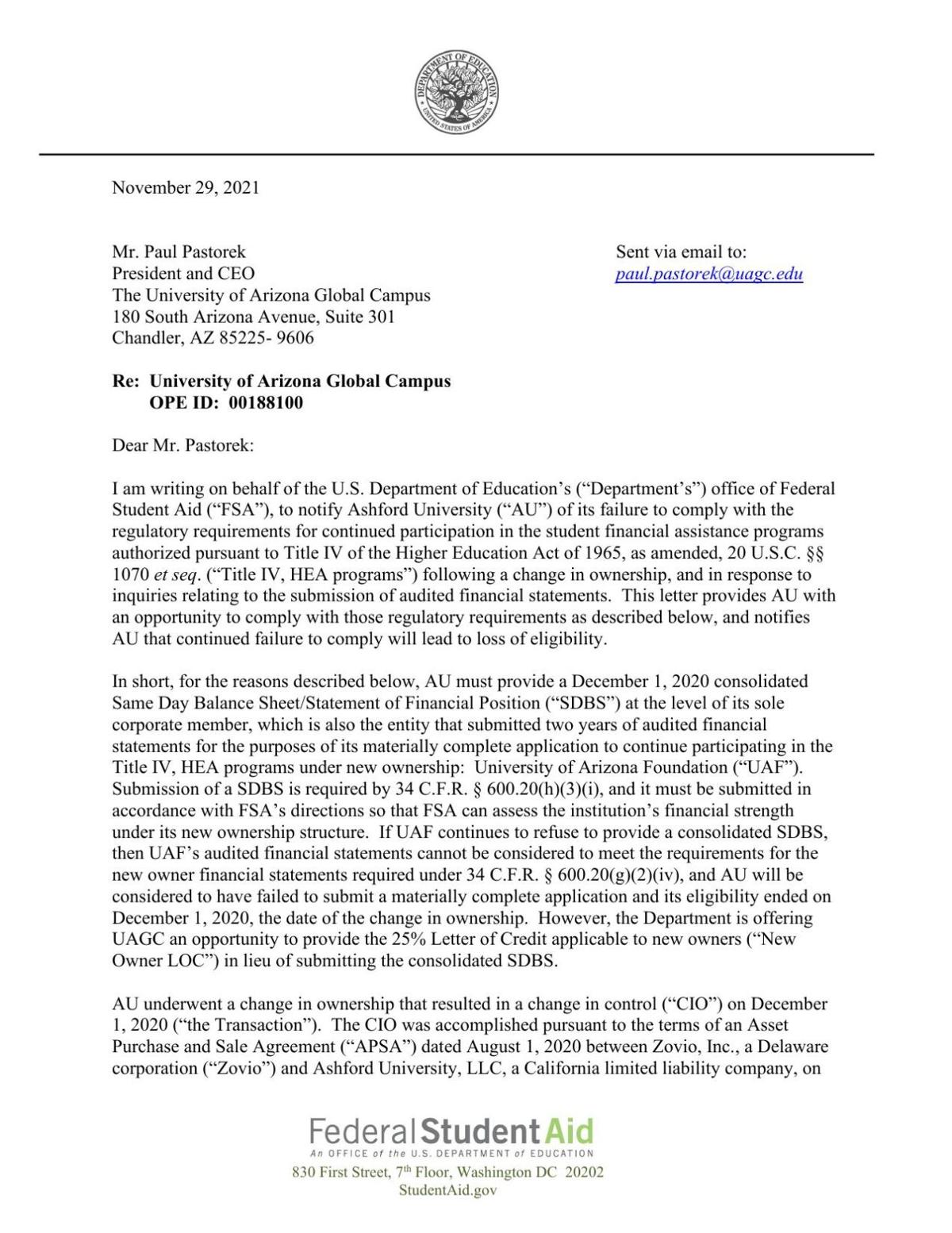The UA has announced plans to fully integrate the University of Arizona Global Campus, the nonprofit online school formerly known as the for-profit Ashford University, into its operation as Arizona’s flagship public university.
The move comes soon after the federal Education Department recently told UA Global Campus that it could be at risk of losing its ability to collect the federal student loans and other forms of student aid many students rely on to pay tuition.
“Open-enrollment postsecondary education is a flexible pathway for a growing number of students across the country, and UAGC is fully committed to providing opportunities for these students’ growth and advancement while providing them an unmatched online educational experience for the 21st century,” UA President Robert Robbins wrote in a letter explaining the move to faculty Tuesday. “This change will be beneficial to the University and to the current and future students enrolled at UAGC.”
Robbins made the announcement to the Arizona Board of Regents at a special meeting Thursday.
“On behalf of the board, I think we are excited to see this process move forward,” Chair Lyndel Manson said in response, the only member to make a public comment. “I look forward to further discussions on the timing of this process and the strategic and policy implications as we move forward.”
Online education
Online higher education is a competitive space in Arizona. ASU, for example, has been growing its online presence for many years. With almost 54,000 students enrolled online in 2021, it has one of the biggest online programs in the nation. The UA’s online presence is much newer and smaller, with around 6,500 students enrolled.
But Robbins dismissed the idea that absorbing UA Global Campus’ approximately 28,000 students is a quick grab to catch up to ASU.
“I’m not focused on what ASU’s doing at all, I’m focused on what we’re doing,” Robbins said in an interview with the Arizona Daily Star. “We started pretty slowly in the online business, and I would say this opportunity gave us the chance to serve a population of students we have not normally served in a scalable way. … There’s no way to compete with (ASU).”
Opposed to the traditional four-year UA college student, Ashford, and now UA Global Campus’ students are more likely to have served in the military and identify as nonwhite and low income.
The UA acquired the assets of Ashford University — which, along with its former parent company Zovio Inc. has been sued in multiple states for consumer protection violations grounded in allegations that it defrauded vulnerable students — in 2020 and rebranded it UA Global Campus. At that time, the deal made clear that the UA and UA Global Campus would remain two separate entities, accredited by two separate agencies and governed by two separate boards for at least three years.
However, the terms of that agreement have since changed, and the UA is in the early stages of absorbing UA Global Campus, the details of which are expected to be ironed out in the coming months.
Department of Education changes
It’s happening right now in part because the U.S. Department of Education sent a letter to UA Global Campus last November alerting the school that because it underwent a change in ownership, it and the UA Foundation would have to either immediately provide the education department a financial audit or a 25% letter of credit valued at $103 million to continue to be eligible to receive Title IV funds, which include Pell Grants and federal student loans.
But after further communication between Robbins and the education department, a new option was agreed upon earlier this month: The UA signed a temporary provisional agreement along with UA Global Campus and the UA Foundation in which the UA is now liable for UA Global Campus’ performance requirements that maintain its eligibility to receive Title IV funds.
The elimination of the original three-year requirement that UA and UA Global Campus remain separate entities is the result of an amendment to the affiliation agreement, which the UA and UAGC voluntarily agreed to. That led the UA to start the process of working with governing bodies and UA faculty and staff on how to approach absorbing UA Global Campus.
Eventually, UA Global Campus will come under the purview of the Arizona Board of Regents, just like the UA is now, and streamline its accreditation to fall under the same accrediting body.
This move comes after 1½ years of strong criticism from some faculty, education advocates and two federal lawmakers, all of whom raised concerns that the UA’s association with an entity with a predatory history could not only continue to harm students, but also the UA’s reputation as a top public research university and expose it to litigation.
According to the most recent data available from the U.S. Department of Education’s College Scorecard, 22% of all Ashford students graduate in eight years, whereas 63% of UA students graduate in the same timeframe; 24% of first-time, full-time undergraduates returned to Ashford after their first year.
“Same institution ... different name”
And those concerns about litigation aren’t a hypothetical.
Closing arguments recently wrapped up in California, where the state’s attorney general took Ashford and Zovio, formerly known as Bridgepoint Education Inc. (Zovio has a 15-year contract with UA Global Campus to provide operation services) to trial for pressuring recruiters to make false promises and using illegal collection tactics when students couldn’t pay up.
Pat Ogden, former vice president of regulatory affairs at Ashford who worked at UAGC until last spring, characterized UA Global Campus as “the same institution under a different name,” according to a court transcript. “Zovio is providing the same enrollment and marketing services for the newly-named University of Arizona Global Campus,” Ogden said. “And Zovio’s historically ineffectual compliance department will continue to exercise oversight over the Zovio admissions counselors enrolling students in UAGC.”
Prosecutors are seeking penalties of $75 million and $25 million in restitution for “harmed” students.
According to UA spokeswoman Pam Scott, that $100 million would be a liability of the defendants in the litigation, Zovio and Ashford University, not the UA or UA Global Campus.
On top of that, UA Global Campus is also dealing with a notice of concern from its accreditor, Western Association of Schools and Colleges Senior College and University Commission.
While UA Global Campus still fully accredited, the body recently concluded a site visit at the school’s headquarters in Chandler to investigate “concerns that the targets set for academic improvement are seriously inadequate to reach levels of student outcomes that should be expected at an accredited institution.” The report from that visit is expected to come next month and the commission could either vote to remove UA Global Campus’ notice of concern or take the more drastic step of sanctioning the school.
Robbins told the Star he’s not particularly worried about the California lawsuit or the accreditation report.
“If you go back and look at what was going on before we stepped in and UAGC was created, there’s clearly court cases — the facts are the facts,” Robbins said. “It’ll be interesting to see what happens in the California case, but regardless of what happens there this is about Zovio. It is not about UAGC. It’s not about the University of Arizona.”
Robbins said his primary concern is serving the students of UA Global Campus.
“By bringing them into the university we can better serve the students than what we’re doing now, which I think is demonstrably better than what was happening before,” he said, adding that integrating UA Global Campus students into the UA will give the university more direct control as to how students are educated.
As for the accreditation issues, he’s prepared to take it as it comes.
“Regardless of what (the accreditor) says, we’re in this,” Robbins said. “We are committed to this. We have great resolve and commitment to these students. We wouldn’t back away and abandon these students even if (the accreditor) said there’s ongoing concern.”
Faculty want representation
In the roughly 18 months since the UA first announced its affiliation with UA Global Campus, a number of faculty members raised concerns about not being included in discussions about the deal. While Robbins said non-disclosure agreements prevented some of that from happening at the outset, he’s ready to engage in shared governance with faculty moving forward.
“I look forward to engaging in discussion with people who continue to be fierce opponents of this,” Robbins said. “I think at the end of the day this is about students and I just don’t know what the argument is to deny students the opportunity to have an education.”
Melanie Hingle, an associate professor of nutrition at the UA and vice chair of the UA faculty, said that at this point she has “more questions than concerns.”
Reflecting on how the original deal was handled in summer 2020, Hingle said the faculty “did not have an adequate opportunity to have consultation.”
She was in the meeting with the Faculty Senate Executive Committee on Monday when Robbins and UA Provost Liesl Folks first announced the acquisition of UA Global Campus.
“I was not aware of any details even after that meeting because it was pretty vague, and I think they don’t know a lot of next steps and they were seeking to engage the faculty senate leaders to ask how they should work with the larger faculty and whatever will happen next,” Hingle said. “As a faculty leader, that is my primary interest in hearing about this — making sure we’re represented.”



